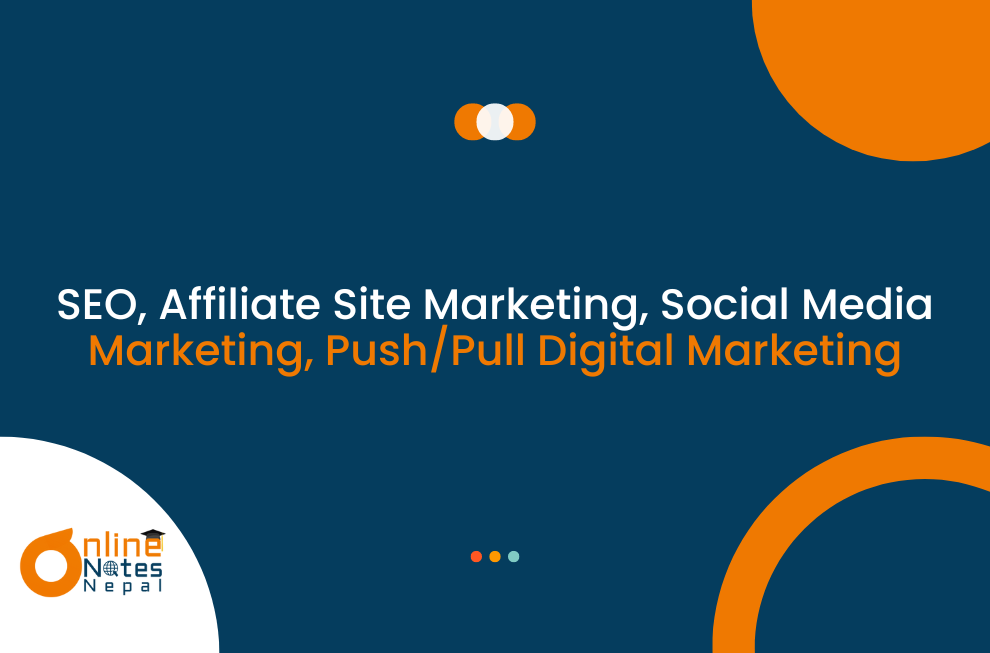SEO, Affiliate Site Marketing, Social Media Marketing, Push/Pull Digital Marketing
SEO is the practice of optimizing a website to improve its visibility and ranking on search engine results pages (SERPs) for relevant keywords.
Key Elements
On-Page SEO: Involves optimizing individual web pages, including the use of relevant keywords, meta tags, headers, and high-quality content.
Off-Page SEO: Focuses on external factors such as backlinks from reputable sites, social signals, and online reputation.
Technical SEO: Ensures the website's technical aspects are optimized, including site speed, mobile-friendliness, secure connections (HTTPS), and proper indexing by search engines.
Content Quality: Creating valuable, informative, and engaging content that answers users' queries and encourages longer site visits.
User Experience (UX): Ensuring a positive user experience with easy navigation, fast load times, and mobile optimization.
Benefits: Increased organic traffic, better brand visibility, higher credibility, and long-term cost effectiveness compared to paid advertising.
Affiliate Site Marketing
Affiliate marketing is a performance-based marketing strategy where affiliates promote a company's products or services and earn a commission for each sale or lead generated through their referral.
Key Components:
- Affiliates: Individuals or businesses that promote products on their websites, blogs, or social media channels.
- Merchants: Companies that offer products or services and provide commissions to affiliates for driving traffic and sales.
- Affiliate Networks: Platforms that connect affiliates with merchants, providing tracking, reporting, and payment services.
- Tracking and Analytics: Tools to monitor clicks, conversions, and commissions to evaluate the performance of affiliate campaigns.
- Payment Models: Common models include pay-per-sale (PPS), pay-per-click (PPC), and pay-per-lead (PPL).
Benefits: Cost-effective, performance-based, scalable, and extends the reach of marketing efforts.
Social Media Marketing
Social media marketing involves using social media platforms to promote products, services, and brands, engaging with the audience, and driving traffic and sales.
Key Platforms:
- Facebook: For community building, targeted advertising, and customer engagement.
- Instagram: Visual content platform ideal for lifestyle, fashion, and consumer products.
- Twitter: Real-time engagement, news updates, and brand interaction.
- LinkedIn: Professional networking, B2B marketing, and industry insights.
- TikTok: Short-form video content targeting younger demographics.
Strategies:
- Content Creation: Developing engaging, relevant, and shareable content tailored to each platform.
- Paid Advertising: Utilizing social media ads to reach a larger and targeted audience.
- Influencer Marketing: Partnering with influencers to leverage their followers and credibility.
- Community Engagement: Interacting with followers, responding to comments, and fostering a loyal community.
- Analytics: Measuring performance using metrics like engagement rates, click-through rates, and conversion rates.
Benefits: Increased brand awareness, customer engagement, direct communication with customers, and the ability to target specific demographics.
Push/Pull Digital Marketing
Push Marketing:
Push marketing involves proactively pushing products or services to consumers through direct channels.
- Examples: Email marketing, SMS marketing, display ads, and direct mail.
- Approach: Often involves interrupting the audience with promotional messages.
- Benefits: Immediate reach, direct communication, and the ability to target specific audiences with tailored messages.
Pull Marketing:
Pull marketing focuses on attracting customers to products or services through content and engagement.
- Examples: SEO, content marketing, social media engagement, and inbound marketing.
- Approach: Involves creating valuable content that draws customers in and encourages them to seek out the brand.
- Benefits: Builds long-term customer relationships, enhances brand credibility, and attracts more engaged and interested customers.
Comparison:
- Push Marketing: More direct and often quicker in generating immediate results but can be perceived as intrusive.
- Pull Marketing: More subtle and customer-friendly, fostering organic growth and engagement, though it may take longer to see results.
Effective Use: Combining the two tactics can create a more balanced approach, leveraging the immediacy of push marketing and the engagement of pull marketing to maximise reach and impact.
